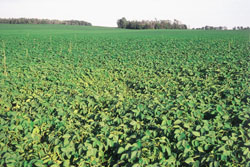
Features
Agronomy
Cereals
Phosphorus fertilizer boosts yields in fallow-wheat production
The role that fertilizer has played in crop production...
March 5, 2008 By Stewart A. Brandt*
The role that fertilizer has played in crop production has been reviewed in a number of past publications, and recently summarized by Stewart et al., 2005. The general consensus is that fertilizers contribute from 30 to 50 percent of crop production in most intensively cropped environments. However, the question is often asked: What is the impact of fertilizer in less intensive environments?
 |
| Phosphorus was applied to the area at left in this photo showing wheat response. Photo Courtesy Of International Plant Nutrition Institute. |
On the northern Great Plains, fallow remains a component of dryland cropping systems (Zentner and Campbell, 1988). While not very efficient, the fallow period contributes to soil moisture conservation which allows for substantial increases in crop yields under very dry environments. When grown on fallow, most crops in this region respond to fertilizer phosphorus (P) additions. These responses are due to low soil P in most of these calcareous soils, and cool soil temperatures at seeding.
A long-term fallow-wheat-wheat rotation study was conducted at Scott, Saskatchewan, to monitor year-to-year crop yields and to evaluate soil quality changes. After 72 years of cropping (1930 to 2002) in a fallow-wheat-wheat rotation, the yields on fallow were evaluated based on growing season precipitation. The 24 driest years (May to July precipitation averaged 4.25in), 24 near normal years (May to July precipitation averaged 6.25in), and the 24 wettest years (May to July precipitation averaged 8.36in) were compared for the response of spring wheat to P fertilizer additions of 30lb/ac P2O5.
The largest percentage gain in yield was achieved during dry years, declining slightly for both near normal and wet seasons (see Table 1). Given the mineralization of nitrogen (N) during the fallow period on these soils, no fertilizer N was applied and no response to N was expected. The grain yield response to fertilizer P additions, ranging from 19 to 29 percent, is less than that reported in earlier publications and reflects on this mineralized soil N. While farmers often consider reducing inputs during dry years, these results suggest that fertilizer P may be an exception. Adequate P from fertilizer may be essential for efficient water use during dry seasons. -end-
| Table 1. Crop yield response to fertilizer P addition to wheat grown on fallow. | ||||
| Treatment | Check (bu/ac) |
P added (bu/ac) |
Gain (bu/ac) |
Gain (percentage) |
| 24 driest years | 18.7 | 24.1 | 5.4 | 9 |
| 24 average years | 24.1 | 28.6 | 4.5 | 19 |
| 24 wettest years | 31.2 | 38.7 | 7.5 | 24 |
| References: Stewart, W.M., D.W. Dibb, A.E. Johnston, and T.J. Smyth. 2005. Agron. J. 2005 97:1-6. Zentner, R.P. and C.A. Campbell.1988. Can. J. Plant Sci. 68: 1-21. | ||||
*Stewart A. Brandt is with Agriculture and Agri-Food Canada in Scott, Saskatchewan; e-mail: brandts@agr.gc.ca
Reprinted from Better Crops with Plant Food, with permission of International Plant Nutrition Institute (IPNI).